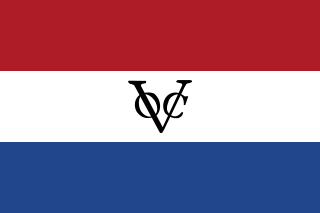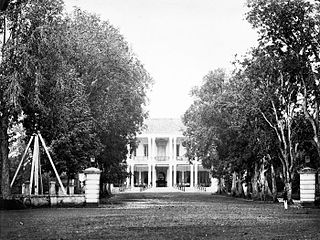
Johannes François Snelleman was a Dutch zoologist, orientalist, ethnographer and museum director. He was a son of Christiaan Snelleman and Sara Lacombe. Snelleman was married three times, to Josepha Hendrika Dupont (1860-1899), Catharina Johanna Elisabeth Augusta Inckel, and Theodora Maria Beun (1887-1964).

The Great East was a governorate (gouvernement) of the Dutch East Indies between 1938 and 1946. It comprised all the islands to the east of Borneo and of Java. Its capital was Macassar on Celebes.

Dutch Celebes refers to the period of colonial governance on the island of Sulawesi - as a commandment of the Dutch East India Company from 1699 until its demise in the early 1800s, and then as a part of the Netherlands Indies or Dutch East Indies until 1945. Dutch presence in the region started with the capture of Sulawesi from the Portuguese, and ended with the establishment of the State of East Indonesia. Celebes is now referred to as Sulawesi. Makassar, the capital, was also referred to as: Macassar, Makassar, Macaçar, Mancaçar, or Goa, Gowa.
Sultan Zainul Abidin was the seventh sultan of Aceh in northern Sumatra. His reign was the last of three brief ones in the year 1579.
Sultan Ali Ri'ayat Syah III was the eleventh Sulṭān of Acèh Darussalam in northern Sumatra. He had a brief and turbulent reign from 1604 to 1607 before being succeeded by his more famous nephew Iskandar Muda.
Sultan Alauddin Muhammad Da'ud Syah I was the thirty-first sultan of Aceh in northern Sumatra. He was the sixth ruler of the Bugis Dynasty and reigned from 1823 to 1838.
Sultan Alauddin Sulaiman Ali Iskandar Syah was the thirty-second sultan of Aceh in northern Sumatra. His largely nominal reign lasted from 1838 to 1857.

Sultan Alauddin Ibrahim Mansur Syah, also known as Ali Alauddin Mansur Syah was the thirty-third sultan of Aceh in northern Sumatra. He was the eighth ruler of the Bugis Dynasty and ruled de facto from 1838, formally from 1857 to 1870.

The Timor and Dependencies Residency was an administrative subdivision (Residency) of the Dutch East Indies located in the Eastern half of Lesser Sunda Islands east of Lombok, it was separated in 1819 from the Governorate of Moluccas (Gouvernement der Molukken. Its capital was at Kupang.

The Dutch East Indies was a Dutch colony consisting of what is now Indonesia. The Anglo-Dutch Treaty of 1824, which ceded Dutch Malacca, a governorate of the Dutch East Indies that was transferred to Great Britain has consolidated modern-day rule to the Malacca state of Malaysia. It was divided into three governorates, namely the Great East, Borneo (Kalimantan) and Sumatra, and into three provinces in Java. Provinces and governorates were further divided into residencies. Residencies under the provinces were divided into regencies, and residencies under governorates were divided into departments and then further into regentschappen.

Tapanoeli Residency was an administrative subdivision of the Dutch East Indies with its capital in Sibolga. It was located in northern Sumatra and existed in various forms from 1844 until the end of Dutch rule in 1942. The area it encompassed at various times corresponds to most of the western coast of the current day Indonesian province of North Sumatra and parts of Aceh, including much of the traditional heartland of Batak people. Lake Toba, a historically important crater lake, was also within the borders of the Residency.

Preanger Regencies Residency, sometimes referred to as Preanger Residency and renamed Priangan Residency after 1931, was an administrative division (residency) of the Dutch East Indies located in Parahyangan, West Java which existed from 1817 to 1925. Its capital was in Cianjur until 1856 and thereafter in Bandung. The residency contained the municipality of Bandung and the regencies of Bandoeng, Soemedang, Tasikmalaja, Tjiamis and Garoet.

Semarang Residency was an administrative subdivision (Residency) of the Dutch East Indies located on the northern coast of Central Java and named after its capital city Semarang. It existed from 1818 to 1942, although its borders were changed many times during that period.

Koedoes Residency was an administrative division (Residency) of Central Java province of the Dutch East Indies with its capital at Kudus, which existed between 1928 and 1931. It was significantly larger than the present-day Kudus Regency, as it also contained Demak Regency and Jepara Regency.

Bantam Residency, sometimes spelled Banten Residency, was an administrative division (Residency) of the Dutch East Indies which existed from 1817 to 1942; it was located at the western point of Java and its capital was at Serang. Its borders largely correspond to the present-day Indonesian province of Banten.

Blora Residency was an administrative division (Residency) of Central Java province of the Dutch East Indies with its capital at Blora, which existed between 1928 and 1931. It was significantly larger than the present-day Blora Regency, as it also contained Grobogan Regency and Purwodadi.

Buitenzorg Residency was an administrative division (Residency) of the Dutch East Indies located in western Java which existed from 1817 to 1867 and from 1925 to 1942. Its seat was at Buitenzorg which was also the seat of the colonial government of the Indies after 1905.

Madoera Residency was an administrative subdivision (Residency) of the Dutch East Indies located on the island of Madura and with its capital at Pamekasan. It also included some smaller islands off Madura such as the Kangean Islands and Sapudi Islands. The Residency was divided into 4 districts : Pamekasan, Bangkalan, Sampang and Soemenep. It existed from the 1880s, when the Dutch established more direct control over the Island, to 1942 when the Japanese invaded the Indies, except for a brief period 1928-31 when it was divided into two smaller residencies.
Afdeling, formerly spelt afdeeling, was an administrative area during the Dutch East Indies colonial administration at the district level. The post of administrator was held by an assistant resident. An afdeling is part of a residency and may consist of several onderafdelingen or "subdistricts" and a landschap headed by an Bumiputera called a hoofd or head.

Sumatra's East Coast Residency was an administrative subdivision of the Dutch East Indies with its capital in Medan. It was located in northern Sumatra. In 1938, there were 10,026 square kilometers of plantations in the northern part of the residency, known as the Estates Area.
















